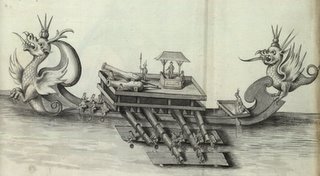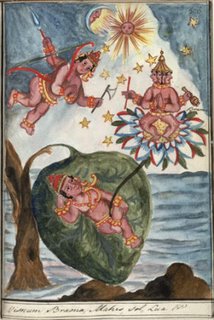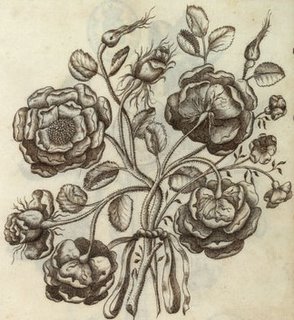Saturday, November 19, 2005
Portuguese National Library Manuscripts
 Nova arte de escrever / offerecida ao Principe Nosso Senhor para instrucção da mocidade composta por Antonio Jacinto de Araújo, Professor d’Escripta, e Arithmetica, e Correspondente da Academia Imperial das Sciencias em S. Petersbourgo. – [1793 ?]
Nova arte de escrever / offerecida ao Principe Nosso Senhor para instrucção da mocidade composta por Antonio Jacinto de Araújo, Professor d’Escripta, e Arithmetica, e Correspondente da Academia Imperial das Sciencias em S. Petersbourgo. – [1793 ?]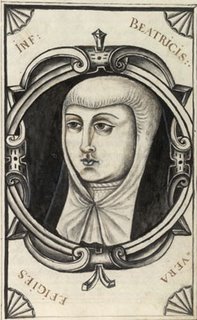 Liuro das antiguidades da cidade de Beja e de outras particulares depend~etes dellas / dirigido a Catholica Magestade de elRey Phelippe nosso Senhor deste nome [e] composto [por Vasco Freire]. – [1610 ?]
Liuro das antiguidades da cidade de Beja e de outras particulares depend~etes dellas / dirigido a Catholica Magestade de elRey Phelippe nosso Senhor deste nome [e] composto [por Vasco Freire]. – [1610 ?] Arte universal de la Guerra / del principe Raymundo Montecugoli Teniente General de las armas del Senhor Emperador ; tradusido de Italiano em Español por Don Bartolome Chafrion Alferes de Infantaria Española del Tercio de Valencia. – 1708
Arte universal de la Guerra / del principe Raymundo Montecugoli Teniente General de las armas del Senhor Emperador ; tradusido de Italiano em Español por Don Bartolome Chafrion Alferes de Infantaria Española del Tercio de Valencia. – 1708A Ilustração na Colecção de Códices da Biblioteca Nacional is a modest exhibition at the Portuguese National Library with illustrations from their rare manuscripts covering emblems, calligraphy, architecture, military, astronomy and manuscript decoration (among other things). It is all in portuguese I'm afraid.
Codex Laud
"Mesoamerican manuscripts, or codices, described wars, victories, famine, pestilence, religious events, and other elements of ancient Mesoamerican culture. They also often functioned as calendars. Priests had a central role in Mesoamerican society and culture and undoubtedly were the creators of the content of the codices."
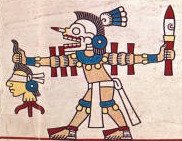
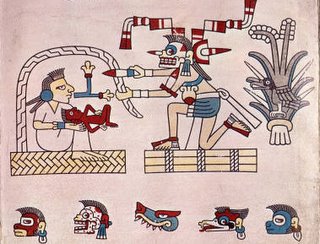
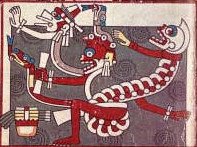
"The codices often consisted of one long extension or band of paper called amatl, produced from the bark of a type of fig tree. A stone beater was used to soften the fibers of the bark. Sometimes the length of paper was creased into the form of an accordion screen. These folded screens could be as long as fifty-two feet."

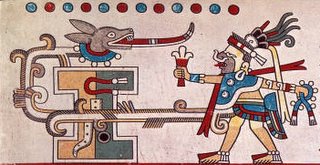
"Glyphs, or pictorial representations, were used for the text. Scribes outlined the figures to define shapes and then colored in each of these drawings. The figures were mostly of various deities combined with animals such as birds, dogs, jaguars, two-headed snakes, and butterflies. Dots were used in conjunction with the glyphs to count the days or months."
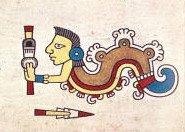
"Great attention was paid to color in order to make the codices visually provocative. Pigments were produced from natural substances like juniper root (red), sweet clover, (yellow), prickly pear cactus (tan), and onionskin (green). The colors were vivid and bright."
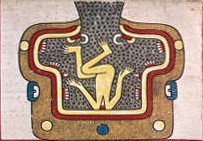
These images from the 16th century Codex Laud, depicting deities from the Aztec-Toltec pantheon, reside on a University of Utah website along with the previously posted Codex Magliabecchi. I seem to recall I was better able to prise the pages/images out of the infernal page viewer last time. The original manuscript is housed in the Bodleian Library at the University of Oxford. Great inspiration for today's illustrators and cartoonists.
Friday, November 18, 2005
Siebold's Voyage
Sophia University have 16 of 72 plates from Voyage au Japon, execute pendant les annees 1823 a 1830, the French translation of a book by Philipp Franz von Siebold. He was responsible for introducing western medicine to Japan among (many) other things. I've previously posted about his Fauna Japonica series and will so again sometime.
There is little in the way of information about this publication on the internet and there seems to be some conflict about how many volumes were in the series. I think the original of this was in Dutch and the original plates retain those captions with added french words (in some). The series was published between 1837 and 1840.
Dressed in Gold
 Cristoforo Majorana - Tree of Jesse Naples, ca. 1480
Cristoforo Majorana - Tree of Jesse Naples, ca. 1480Christ and the Tree of Jesse; Putti in the Margins. Church Psalter
 Master of the Revelations
Master of the Revelationsof Saint Bridget of Siena
Panel Miniature with the Monk John Climacus;
Historiated Border with Exemplary Scenes of
Eremitic LifeSiena,late 14th century [detail]
 Bartolomeo Sanvito - The Triumph of Eternity
Bartolomeo Sanvito - The Triumph of Eternity(Depicted as Christ Upheld on the Cross by God,
Surrounded by a Mandorla of Angel Heads)
from 'I Trionfi (The Triumphs)'
by Francesco Petrarch Florence,15th century [detail]

Bartolomeo Sanvito - The Triumph of Time
(Depicted as Father Time on a Stag-drawn Cart,
Accompanied by the Ages of Man)
from 'I Trionfi (The Triumphs)'
by Francesco Petrarch Florence, 15th century
[The top image isn't labelled because I'm presently getting 'cold fusion' errors for the site these come from, but I want to post it because this has taken a looonngg time for various reasons to get together and I can't be sure when the server will be back up (I'm sure it will be back).]
Dressed in Gold: Books of the Italian Renaissance is an exhibition presently showing at the Walters Art Museum in Baltimore and they are to be commended for posting a fair sampling of their collection online. This is not a research site so the manuscripts appear to be incomplete but they do have screen size jpegs available.
The website is "an illustrated catalogue of the extraordinary collection of rarely seen 14th and 15th century manuscripts held by the Walters Art Museum. This site allows you instant access to over 400 folios (pages) of 29 manuscripts produced in Venice, Milan, Rome, Florence, and Naples during the Italian Renaissance. You will be able to fully explore the artistic achievements of the different regions in manuscripts ranging from liturgical texts to private prayer books, and from classical poetry to diplomatic documents."
I only have an amateur appreciation for illuminated manuscripts but I do like to peruse them occasionally and these are fine specimens. The real world exhibition goes until January 2006
Addit: I went over to PECIA (a great weblog about medieval manuscripts) after posting this to see if Jean-Luc had heard about it and of course he posted it yesterday. But he also advises of the extensive Archimides Palimpsest project website, also under the auspices of the Walters Art Museum.
"This tenth century manuscript is the unique source for two of Archimedes Treatises, The Method and Stomachion, and it is the unique source for the Greek text of On Floating Bodies. Discovered in 1906 by J.L. Heiberg, it plays a prominent role in his 1910-15 edition of the works of Archimedes, upon which all subsequent work on Archimedes has been based...This site presents a summary of six years of work to conserve, image and study the Archimedes Palimpsest"
Thursday, November 17, 2005
From Warsaw to Washington
"Polish Declarations of Admiration and Friendship for the United States is a presentation of the first 13 manuscript volumes of a larger collection of 111 volumes compiled in Poland in 1926 and delivered to President Calvin Coolidge at the White House to honor the 150th anniversary of the Declaration of Independence" in the Manuscript Division of the Library of Congress.
"Richly illustrated with original works by prominent Polish graphic artists, the collection includes the greetings and signatures of national, provincial, and local government officials, representatives of religious, social, business, academic, and military institutions, and approximately 5 ½ million school children."I'm just astounded by the extent to which the Polish emissaries went in the name of friendship and diplomacy. Imagine if President Coolidge had turned around and presented them with a plate or a vase!
Festival at Antwerp
"In Europe in the 16th, 17th and 18th centuries, important events in the life of a princely dynasty, such as marriage, the birth or christening of an heir, a coronation or a funeral, were celebrated by mounting a festival.
Religious festivals took place on saints' days and significant dates in the Church calendars. Festivals also occurred when a prince made a formal entry into a city, either at home or abroad. The term ‘festival’ refers as well to the artistic elements that accompanied these occasions, such as: theatrical, operatic or ballet performances; equestrian, aquatic or firework displays; temporary architectural constructions."
" Festival books were usually published to honour the court or city which hosted the festival. As official publications, they tell us about the image the authorities wanted to project and offer us insights into inter-state alliances, rivalries and other political circumstances. They provide the names and relative standing of prominent courtiers and citizens. They tell us about the artistic styles of the period: its literature, theatre, visual arts and music, and its scenography and architecture. We learn something about economics, social organisation and the luxury trades.La ioyeuse [et] magnifique entrée de monseigneur Francoys, fils de France, et frere unicque du roy, par la grace de dieu, duc de Brabant, d'Anjou, Alencon, Berri, [et]c. en sa tres-renomée ville d'Anvers 1582 at the British Library, part of the Renaissance Festival Books exhibition.
But festival books do not always provide an accurate record of events. Sometimes prepared in advance of the occasion, sometimes seen from the limited viewpoint of an eye-witness, their accounts are ideal, and even idealised, rather than strictly factual."
[The entry of François de Valois, duc d'Alençon into Antwerp]
The illustrations and 21 engravings for this book were completed by Crispin van den Broeck and Adam de Bruyn and the printer was Christophe Plantin. The text describes the journey from Dover, ceremonial investiture as duc de Brabant and François de Valois's entry into Antwerp.
Public Health Posters




Public Health Posters from around the world at Amsterdam University Library (the opening page is in english). There are ~150 posters digitized from their collection.
"The collection Public Health Posters contains educational posters from the period 1914-1960. These posters have themes such as prevention, accidents in the workplace and at home, as well as traffic accidents, tropical medicine, the prevention of tuberculosis, venereal diseases, and cancer."
The Exquisite Corpse

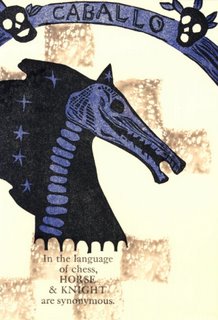




This is all a bit too surreal to provide any meaningful commentary (and I daresay I might be crossing a picket line if I do) but suffice it to say that...
The Exquisite Horse exhibition resides in ether rented by the Univserity of Wisconsin and..
A History of the Cadavre Exquis doesn't but..
The Exquisite Corpse has a history.
Wednesday, November 16, 2005
In the Manner of Manors
"Another interesting relic preserved in the Great [Horeham] Hall is the side-saddle of Queen Elizabeth; the pommel is of wrought metal and has been gilt, the ornament upon it is in the then fashionable style of the Renaissance; the seat, of velvet, is now in a very ruinous condition; but it is carefully kept beneath a glass case, as a memento of the queen's visits to this place.
When Princess, Elizabeth retired to Horeham as a place of refuge during the reign of her sister Mary; the loneliness of the situation, and its distance from the metropolis, rendered it a seclusion befitting the quietude of one anxious to remain unnoticed in troublous times. A room on the first floor in the square tower .. is shewn as that in which Elizabeth resided. She found the retirement of Horesham so agreeable, that often after she had succeeded to the crown she took a pleasure in revisiting the place."
The Baronial Halls, and Ancient Picturesque Edifices of England in 2 volumes (1858) by Samuel Carter Hall is digitized and on display at the Posner Library, Carnegie Mellon University website. Samuel Carter Hall: wikipedia. [more]
The principal drawings were done by J.D. Harding, G. Cattermole, S. Prout, W. Muller, J. Holland and there are 71 coloured lithographic plates between the volumes. Of the plates that I viewed, all were made by W Walton (Del and lith.) and the lithotinting/printing was the work of M&N Hanart, Lithographers. There are also numerous detailed woodblock images throughout the text.
The images above are all from Volume II. Although the books were published in 1858 it seems obvious that some of the drawings were done much earlier by the look of the clothing. However, the text reads like a real estate guide on steroids, but with a posh accent. In a good way.




